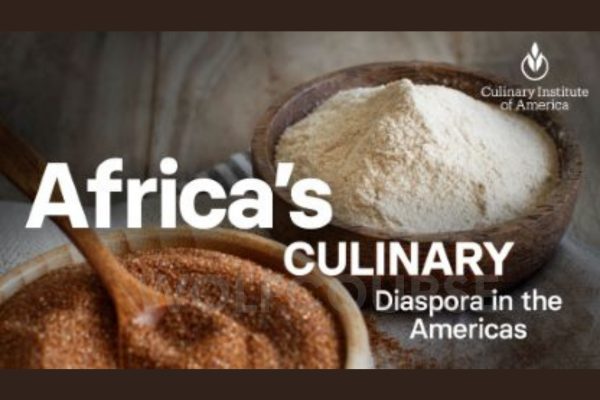Africa’s Culinary Diaspora in the Americas By The Culinary Institute of America
$5.00
Africa’s Culinary Diaspora in the Americas – Immediate Download!
Let See The Content Inside This Course:

Description:
The culinary world is a mosaic of flavors, colors, and histories that tell stories of migration, adaptation, and resilience. In “Africa’s culinary diaspora in the Americas,” edited by the Culinary Institute of America, readers are taken on a profound journey through the historical and contemporary expressions of African cuisine in the Americas. This remarkable compilation presents nine virtual lessons, designed to illuminate the cultural evolution of African culinary traditions from Senegal to the American South. Food serves as a lens through which we can deeply understand the intertwined fates of African descendants as they forged new identities across vast oceans. It becomes a celebration, an exploration, and a reflection on the inherent power of food that transcends borders and generations.

Historical Context of African Culinary Traditions
The deep roots of African culinary practices are intricately woven into the fabric of the Americas, shaped through the harrowing experiences of the transatlantic slave trade. Enslaved Africans brought with them rich culinary landscapes from diverse regions such as Ethiopia, Senegal, and the culturally rich areas of the African continent. What began as a survival mechanism evolved into a rich tapestry of dishes that incorporated indigenous ingredients and European culinary techniques. The influence of these original practices can be seen vividly in the culinary traditions of several nations, including Cuba, Brazil, Jamaica, and Haiti.
One can draw parallels between the ingredients found in West African dishes and those that adorn the tables of American homes today. For example, the use of okra, a staple in dishes such as gumbo, can be traced back to African cooking methodologies. In nations like Brazil, the culinary technique of using coconut milk and spices showcases an adaptation of flavors that emerged as African, indigenous, and European traditions blended into a unique culinary identity. The richness of this historical narrative stands as a testament to the ingenuity and resilience of African-descended communities in the Americas.
The Role of Food in Cultural Identity
Food transcends mere sustenance; it encapsulates memories, identities, and cultural heritages. Among African-descended communities, culinary traditions have served as a critical means of preserving cultural identity amidst adversity. From family gatherings to community celebrations, the preparation and sharing of traditional dishes create a strong emotional bond that fosters a sense of belonging. Many families continue to pass down recipes that have been handed down through generations, serving not only to satisfy hunger but also to honor ancestral legacies.
Key Elements of Culinary Identity
- Heritage Preservation: Traditional recipes are safeguarded and celebrated as integral aspects of cultural identity.
- Community Bonding: The act of cooking and sharing food fosters social connections.
- Symbol of Resistance: Culinary practices can serve as acts of defiance against erasure and a means of asserting identity.
The combination of these elements transforms food from simple nourishment into a powerful form of expression, with every dish telling a story of migration, adaptation, and resilience.
Contemporary Practices and Regional Varieties
As culinary traditions evolved, different regions in the Americas adapted these foundational African influences into their unique culinary landscapes. This blending produced vibrant variations of African-inspired dishes that showcase the rich diversity within the diaspora. The Culinary Institute of America highlights how these regional adaptations have created a dynamic exchange of culinary techniques and flavors that resonate deeply within local contexts.
In specific countries, we see clear manifestations of this cultural amalgamation. Dishes like moqueca (Brazilian fish stew) exhibit African techniques in the use of palm oil and spices, while jerk chicken hailing from Jamaica is rich in flavors brought over from West Africa. Eating gumbo in Louisiana offers a taste of the intricate blend of African, Native American, and French culinary practices.
Notable Dishes and Influences
| Dish | Region | Key Ingredients | Cultural Significance |
| Gumbo | Southern USA | Okra, andouille sausage, crustaceans | Fusion of African and Creole |
| Jerk Chicken | Jamaica | Scotch bonnet peppers, allspice | Symbol of resistance and identity |
| Moqueca | Brazil | Coconut milk, palm oil, fish | Reflection of African heritage |
| Pigeon Pea Stew | Haiti | Pigeon peas, spices | Embracing heritage through flavors |
Each of these dishes reflects a rich lineage of adaptation, demonstrating how African culinary practices persisted and morphed into new traditions. This evolution is not merely a cookbook affair; it is a vibrant expression of culture and community that has defined, and continues to define, African diaspora identities across the Americas.
The Role of Food as a Cultural Bridge
Beyond the kitchen, food plays a critical role as a cultural bridge that links different peoples and communities. It narrates the stories of struggle and triumph, migration, and adaptation. “Africa’s culinary diaspora in the Americas” not only captures the historical narratives but also spotlights food as an instrument of reconciliation and unity. Within communal spaces, kitchens act as crucibles where shared experiences meld, creating flavors that evoke nostalgia and forge connections among generations.
The lessons presented in this compilation dive into the emotional ties associated with food. Culinary experiences remind us of joyous gatherings, the warmth of familial bonds, and the multicultural influences that shaped our palates. In many ways, the act of cooking becomes a means to reenact history, giving individuals an opportunity to connect with their ancestral heritage through the meals they prepare and share.
Food as a Narrative Tool
- Storytelling: Every dish tells the story of its origins, influences, and transformations.
- Cultural Exchange: Culinary practices enable cross-cultural interactions that enrich the social fabric.
- Heritage Recognition: Dishes can play a role in recognizing and valuing diverse cultural narratives.
This exploration of African dietary influences emphasizes that food does not stand alone; it thrives within the intricate interplay of cultural histories and community rituals that define our identities.
Conclusion
“Africa’s culinary diaspora in the Americas” captures the vibrant and ongoing saga of African foods that have shaped the culinary landscapes of numerous countries across the Americas. The emotional and cultural weight of these dishes reflects stories of resilience and adaptation, crafting a beautiful narrative of survival and identity. Through the lens of cuisine, we gain insights not just into the food itself but into the lived experiences of those who contributed to its evolution. This collection serves as both an educational testament and a heartfelt celebration of the rich connections formed through culinary exchanges, showcasing that food is indeed much more than mere sustenance; it is a profound expression of our shared humanity.
Frequently Requested Enquiries:
Innovation in Business Models: We use a group purchase approach that enables users to split expenses and get discounted access to well-liked courses. Despite worries regarding distribution strategies from content creators, this strategy helps people with low incomes.
Legal Aspects: There are many intricate questions around the legality of our actions. There are no explicit resale restrictions mentioned at the time of purchase, even though we do not have the course developer’s express consent to redistribute their content. This uncertainty gives us the chance to offer reasonably priced instructional materials.
Quality Control: We make certain that every course resource we buy is the exact same as what the authors themselves provide. It’s crucial to realize, nevertheless, that we are not authorized suppliers. Therefore, our products do not consist of:
– Live meetings or calls with the course creator for guidance.
– Entry to groups or portals that are only available to authors.
– Participation in closed forums.
– Straightforward email assistance from the writer or their group.
Our goal is to lower the barrier to education by providing these courses on our own, without the official channels’ premium services. We value your comprehension of our distinct methodology.
Be the first to review “Africa’s Culinary Diaspora in the Americas By The Culinary Institute of America” Cancel reply
You must be logged in to post a review.

Reviews
There are no reviews yet.